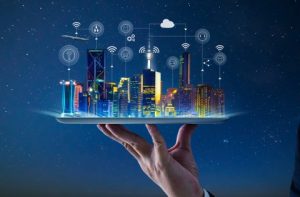How can my municipality or city use IoT?
Municipalities and cities can use IoT (the Internet of Things) to dramatically improve their productivity, public safety, general efficiency, and more. IoT connects various public services and can provide a bird’s-eye view of what is going on at any given moment in the city.
How does this work? Let’s take a look at what IoT is and how to proactively implement it into a 21st-century city.

What Is the Internet of Things?
The Internet of Things is a name for the networks that are created when physical objects are connected to the Internet and can exchange information between themselves. The reason that multiple IoTs exist is that the Internet of Things is not universal among all connected devices.
This works fairly well for applications such as smart homes or personal devices. But how does the IoT scale to the size of a city or municipality’s network?
How Can the IoT Be Practically Used In a City or Municipality?
To understand how IoT can be used in a city or municipality, people need to understand how physical objects connect to these networks. There are five main ways to connect:
- Sensors
- Networks
- Standards
- Augmented intelligence
- Augmented behavior
To use, simply connect areas such as public safety, administration, security, and health in some way to your city’s new network specifically built for them.
Nothing is quite that easy, however. Even in this brief overview, there’s one more piece to this simplified version.
What Does a City Need to Use the IoT?
In order to fully utilize the Internet of Things, large city and municipal organizations need some sort of system to which every device and sensor comes back. This system needs to be able to store and analyze large amounts of data. Then, cities and municipalities need a program to generate reports in order for its users to make educated decisions for the future.
Most often, this is fulfilled by a CMMS (computerized maintenance management system). There are many CMMS lists about the products available on the market, but it is important to chose the right solution for your facility. A CMMS' ROI (return on investment) comes from its abilities to store and analyze the raw data that is collected from all of the connected devices. This data is processed and translated into actionable items, communicated to maintenance teams through their CMMS.
Want to keep reading?
How IoT Works: The Four Factors That Make IoT Possible
What is the difference between IoT and IIoT?
IoT use Cases (Internet of Things) for Commercial and Industrial Business
4,000+ COMPANIES RELY ON ASSET OPERATIONS MANAGEMENT
Leading the Way to a Better Future for Maintenance and Reliability
Your asset and equipment data doesn't belong in a silo. UpKeep makes it simple to see where everything stands, all in one place. That means less guesswork and more time to focus on what matters.

![[Review Badge] Gartner Peer Insights (Dark)](https://www.datocms-assets.com/38028/1673900494-gartner-logo-dark.png?auto=compress&fm=webp&w=336)
